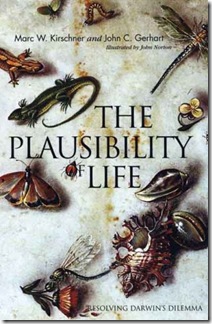Is life plausible? Well, it's more than plausible, it has actually happened! What we need to ask, rather, is whether our explanations for how life came about and diversified are plausible. So the title of Marc W. Kirschner and John C. Gerhart's book implies the wrong question. Despite that, The Plausibility of Life makes for informative and enjoyable reading, and the issues the authors raise are worthy of attention.
The book takes as its starting point the position that the currently accepted version of evolutionary theory, the so-called Modern Synthesis, although not wrong, is incomplete. Similar rumors have been circulated in other recent books, including Mary Jane West-Eberhard's Developmental Plasticity and Evolution, Eva Jablonka and Marion Lamb's Evolution in Four Dimensions, and Phenotypic Evolution, a book by Carl Schlichting and myself. But those rumors have been strenuously denied by researchers who have situated their careers squarely within the Synthesis, which came of age in the 1930s and 1940s.
The two key questions concerning The Plausibility of Life, then, are, Do we actually need to add more components to the structure of evolutionary theory? And if so, is Kirschner and Gerhart's book the contribution some of us have sought for years? The answer to the first question is a definite "yes," and to the second one, a qualified "partially so." Let me explain.
The Modern Synthesis itself built on Darwin's two major realizations: first, that all living organisms are related to one another by common descent; second, that a primary explanation for the pattern of diversity of life—and especially for the obvious "fit" of organisms to their environments—is the process that he called natural selection. It took about seven decades for biologists to add the next round of important building blocks to the Darwinian view of life. Modern Synthesists such as Theodosius Dobzhansky, Ernst Mayr, George Gaylord Simpson and G. Ledyard Stebbins reconciled disparate fields of biology, from population genetics to paleontology, by expanding the array of evolutionary processes to include migration, mutations, assortative (nonrandom) mating and (random) genetic drift. (click for full review)
http://rapidshare.com/files/118967879/kitap24.rar (3428 KB, şifre: 24kitap28657)




No comments:
Post a Comment